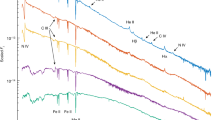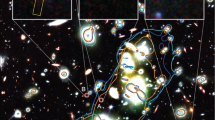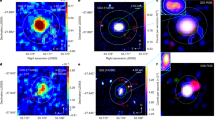Abstract
Recent studies of dwarf novae in the UV and X-ray regions have suggested that much of the energy produced in a dwarf nova is emitted in the far-UV and extreme-UV regions (100–1,200 Å). We report here on observations of SS Cyg and U Gem obtained with the Voyager UV spectrometers (UVS) in the 500–1,200 Å region. SS Cyg has been detected in quiescence at a flux level of 9 × 10−13erg cm−2 s−1Å−1at 1,000 Å. U Gem was not detected in quiescence. No emission shortward of the Lyman limit (912 Å) is detected in either star. Observational upper limits to the extreme-UV flux in the 540–740 Å band from SS Cyg and U Gem correspond to 2 × 10−13erg cm−2 s−1Å−1. A far-UV (λeff= 1,050 Å) light curve for an outburst in SS Cyg is presented. The slope of the far-UV flux distribution during the rise to maximum is observed to be correlated with the UV brightness. The nature of this correlation supports the suggestion that the outburst begins at the outer edge of the accretion disk and moves inward. The far-UV flux distributions of SS Cyg and U Gem in outburst were found to be remarkably similar, both exhibit a substantially flatter (Fλ∝ λ −0.5) distribution than that observed in the IUE–UV (Fλ∝ λ−2.3). This result is contrary to current disk models which predict a continued rise in flux in the far-UV. Evidence for a wind in the Lyman lines of hydrogen is seen in SS Cyg. No evidence of a wind was observed in U Gem.
This is a preview of subscription content, access via your institution
Access options
Subscribe to this journal
Receive 51 print issues and online access
$199.00 per year
only $3.90 per issue
Buy this article
- Purchase on Springer Link
- Instant access to full article PDF
Prices may be subject to local taxes which are calculated during checkout
Similar content being viewed by others
References
Broadfoot, A. L. et al. Space Sci. Rev. 21, 183–205 (1977).
Holberg, J. B., Forrester, W. T., Shemansky, D. E. & Barry, D. C. Astrophys. J. 257, 656–671 (1982).
Eason, E. E. & Worden, S. P. Publ. astr. Soc. Pacif., 95, 58–60 (1983).
Hassall, B. J. M. et al. Mon. Not. R. astr. Soc. 203, 865–885 (1983).
Oke, J. B. & Wade, R. A. Astr. J. 87, 670–679 (1982).
Panek, R. J. & Holm, A. V. Astrophys. J. 277, 700–709 (1984).
Córdova, F. A. & Mason, K. O. in Accretion Driven Stellar X-ray Sources (eds Lewin, W. H. G.&ven den Heuval, E. P. J.) (Cambridge University Press, 1982).
Córdova, F. A., Chester, T. J., Mason, K. O., Kahn, S. M. & Garmire, G. P. Astrophys. J. (in the press).
Ritter, H. Catalogue of Cataclysmic Binaries, Low-Mass X-Ray Binaries and Related Objects (Max-PIanck-Institut für Physik und Astrophysik, Garching, 1983).
Pringle, J. E. A. Rev. Astr. Astrophys. 19, 137–162 (1981).
Kamper, K. W. in White Dwarfs and Variable Degenerate Stars (eds Van Horn, H. M.&Weidemann, V.) 494 (University of Rochester Press, 1979).
Wade, R. A. Astr. J. 84, 562–566 (1979).
Córdova, F. A. & Mason, K. O. Astrophys. J. 260, 716–721 (1982).
Author information
Authors and Affiliations
Rights and permissions
About this article
Cite this article
Polidan, R., Holberg, J. Far-UV and extreme-UV observations of SS Cyg and U Gem from Voyagers 1 and 2. Nature 309, 528–530 (1984). https://doi.org/10.1038/309528a0
Received:
Accepted:
Issue Date:
DOI: https://doi.org/10.1038/309528a0
This article is cited by
-
Observations and theory of cataclysmic variables: On progress and problems in understanding dwarf novae and nova-like stars
Space Science Reviews (1994)
-
Multifrequency behayiour of the dwarf nova SS Cygni
Astrophysics and Space Science (1990)
-
The decay of dwarf nova outbursts
Space Science Reviews (1985)
Comments
By submitting a comment you agree to abide by our Terms and Community Guidelines. If you find something abusive or that does not comply with our terms or guidelines please flag it as inappropriate.



